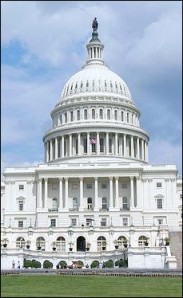Though not covered as extensively as the presidential battle and most Senatorial campaigns, the 435 US House races also figure prominently in next Tuesday’s ballots. While little drama exists concerning these campaigns from an aggregate context, it is still likely that as many as 80+ non-incumbents could win seats for the first time. There are 62 open seats, and easily another 18 to 30 House members could lose their seats.
The current partisan makeup of the House of Representatives is 240 Republicans and 190 Democrats, with five vacancies, three from Democratic seats and two Republican. Today, our House race handicapping chart shows that 229 congressional districts are “safe,” “likely” or “leaning” for the Republican candidate, and 180 districts are “safe”, “likely”, or “leaning” for the Democratic standard bearer, with 26 “tossup” districts that both parties have some chance of winning. In order for the Democrats to re-capture the majority lost two years ago, they would need a net gain of 25 seats from their current level just to reach the bare minimum of 218. With this numerical obstacle standing before them, and in order for the minority party to regain power, they would need a “wave” election, something that has little chance of occurring.
Recent examples of wave elections are the Republican sweep of 2010 and Democratic waves of 2006 and ’08 that drastically changed the composition of the House. Historically, wave elections are driven by the party with a substantial and unparalleled lead going into Election Day. The GOP netted 63 seats in the 2010 midterm election and conversely, Democrats won 31 seats in 2006, followed by another 25 two years later. If campaign historical trends are a true future indicator, as best detected by polling, then 2012 will not be a wave election. As the cycle progressed we have seen a good deal of movement in many races that began as clearly favoring one party or the other. Two contrasting swing races from the west and east are Washington state’s 1st Congressional District and the fast-emerging NY-21.
The Evergreen State has produced a top swing-seat battle in the new 1st Congressional District that was redrawn in a more competitive fashion as part of a deal among the members of the bi-partisan Washington State Redistricting Commission. In exchange for making the previously Democratic 1st District politically marginal and shoring up Republican Jaime Herrera Beutler in the new 3rd District, incumbent Rick Larsen (D) received a safe new 2nd District and the state’s additional seat, the 10th District gained in the national reapportionment formula, was made a Democratic safe haven.
In March of this year, Democratic Rep. Jay Inslee (WA-1) announced his resignation from the House in order to fully focus on his gubernatorial campaign. His vacancy was quickly flooded with interest and, after a hotly contested Democratic primary, former Microsoft executive Suzan DelBene (D) and Snohomish County councilman and ex-state Rep. John Koster (R) won the right to face off against each other in what polling continues to show is a close match-up.
In this key swing seat, a significant amount of money has been spent by outside groups including both the Democratic Congressional Campaign Committee (DCCC) and the National Republican Congressional Committee (NRCC). Recently an independent Survey USA poll (Oct. 19-21; 610 likely WA-1 voters) found DelBene leading Koster by three points, 47-44 percent. The new poll, compared to a previous S-USA study conducted five weeks prior, found that DelBene has increased five points in support, while Koster has lost two points. The results also determined that DelBene has a greater advantage with self-described moderates and independents.
Turning to the St. Lawrence Seaway region along the Canadian border on the north and Lake Champlain to the east is the new NY-21 District and Republican Matt Doheny could be moving into upset position. Lagging behind for most of the race, Doheny has emerged as a serious threat at precisely the right time. Two different polls forecast a closing race. Incumbent Bill Owens released his own data (Global Strategy Group; Oct. 21-23; 403 likely NY-21 voters) staking him to a 47-40 percent lead. But, another independent survey detected a much different result. Siena College (Oct. 29-30; 629 likely NY-21 voters) found the race to be much closer. According to the Siena data, Doheny is up by just one percentage point, 44-43 percent. Clearly, this campaign is very much alive turning into the final weekend.
While a good deal of uncertainty still remains in precisely predicting the composition of the new Congress, it is likely that Republicans will maintain control with their current margin potentially in tact.


